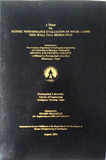Please use this identifier to cite or link to this item:
https://elibrary.khec.edu.np/handle/123456789/862Full metadata record
| DC Field | Value | Language |
|---|---|---|
| dc.contributor.advisor | Dr. Bijaya Jaishi; Dr. Raghabendra Yadav | - |
| dc.contributor.author | Prabin Prajapati | - |
| dc.date.accessioned | 2025-02-10T10:25:58Z | - |
| dc.date.available | 2025-02-10T10:25:58Z | - |
| dc.date.issued | 2024 | - |
| dc.identifier.uri | https://elibrary.khec.edu.np:8080/handle/123456789/862 | - |
| dc.description.abstract | Bridges, as critical lifeline structures, must be designed with the utmost care to ensure their functionality post-earthquake. Studies have shown that ground motion near the seismic source is more intense than in other locations during the same earthquake due to the fact that ground motion cannot be significantly attenuated near seismic source. This study has been carried out to determine the seismic performance of double limb thin wall tall (DLTW) bridge pier using seismic nonlinear analysis and fragility analysis. A typical DLTW tall pier bridge has been selected for the research. The bridge pier is modeled in finite element analysis based program OpenSees. For the seismic analysis, pushover analysis and non-linear time history analysis have been performed to evaluate capacity and demand of the tall bridge pier respectively. Pushover curve has been utilized for developing the capacity spectrum from which the threshold strain in longitudinal steel bar for different damage states were defined. Similarly, seven different time histories with proper scaling have been used for the evaluation of demand. Finally, fragility curves were developed following the Probabilistic Seismic Demand Model method for the four limit states: slight damage, moderate damage, extensive damage and complete damage to obtain the probability of damage due to various levels of strong ground motions. From pushover analysis, capacity curve has been developed and the maximum strain capacities are found to be 0.06 and corresponding displacement capacity is 4745.84 mm in transverse direction. It is also concluded from pushover analysis that concrete fails early than steel member. It was observed that pulse in ground motion has increased the seismic demand. Furthermore, the effect of vertical component of ground motion has not significantly change the response of pier in terms of top displacement and strain in rebar. Using fragility curve it is concluded that probability of damage of DLTW pier for 0.4g earthquake are 61.66%, 29.01%, 10.35% and 7.12% for slight, moderate, extensive and complete damage respectively due to horizontal component only while 72.71%, 38.65%, 14.90% and 10.45% for slight, moderate, extensive damage and complete damage due to horizontal and vertical component of ground motion. From the comparison of fragility curve of bridge pier, it can be said that there is significant increase in probability of exceedance of damage state due to influence of vertical component of ground motion | - |
| dc.format.extent | 125 p | - |
| dc.title | Seismic Performance Evaluation Of Double Limb Thin Wall Tall Bridge Pier | - |
| dc.type | Thesis | - |
| local.college.name | Khwopa Engineering College | - |
| local.degree.department | P. G. Department of Earthquake Engineering | - |
| local.college.batch | 2076 | - |
| local.degree.name | ME Earthquake | - |
| local.degree.level | Masters | - |
| local.item.accessionnumber | D.1525 | - |
| local.item.reportnumber | PU Regd: 035-3-3-07435-2019 | - |
| Appears in Collections: | Master of Science (M.Sc) in Earthquake engineering | |
Files in This Item:
| File | Description | Size | Format | |
|---|---|---|---|---|
| 019_Prabin prajapati.pdf Restricted Access | 5.36 MB | Adobe PDF |  View/Open Request a copy |
Items in DSpace are protected by copyright, with all rights reserved, unless otherwise indicated.
